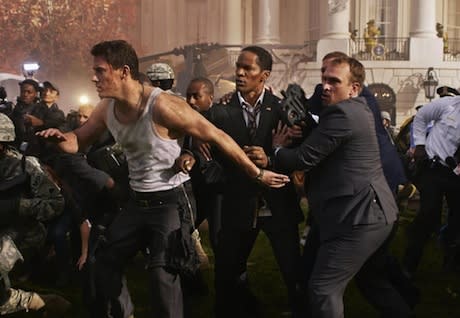You know what you're in for when you pop in the disc and the loading bar is superimposed over an image of an exploding White House. The second (and better) of the President-in-peril blockbusters released this summer, White House Down marks the triumphant return of director Roland Emmerich (Independence Day, The Day After Tomorrow) to the action genre and cements Channing Tatum's status as one of Hollywood's rising stars. It revels in the same formulas that characterized blockbusters of the '90s, offering an overstuffed plot that rarely introduces a shred of information or character detail that won't play a crucial role somewhere else along the way.
The first act takes its time setting up all of its key players before launching them into crisis mode. John Cale (Tatum) is working security detail in Washington for the Speaker of the House (Richard Jenkins), and uses his good looks to help set up an interview with Special Agent Finnerty (Maggie Gyllenhaal) that could lead to protecting President Sawyer (Jamie Foxx) as a member of the Secret Service. He brings along his young daughter Emily (Joey King) to the White House for the occasion, an expert on all things political who he seems to perpetually disappoint since the divorce from her mother (Rachelle Lefevre).
When terrorists take over the building and it's revealed that the head of the Secret Service (James Woods) is behind it all, Cale attempts to keep the president safe from harm as they're pursued all over the White House grounds. The action and pyrotechnics throughout as they race from elevator shaft to secret tunnel to roof are as impressive as you would expect from Emmerich, who even manages to stage an improbably chase scene involving the president's armored limo on the White House lawn.
While the chemistry between Foxx and Tatum feels genuine, the supporting cast helps to elevate some choice roles. Woods seems to especially relish playing the bad guy, bringing actual depth to the heinous deeds he perpetrates in creating a worthy villain for our heroes to combat. The film isn't exactly reinventing the wheel, but at least it understands that all of the explosions and gunfights mean little if you're not sufficiently invested in the people involved.
The disc's supplemental material repackages some of the same interviews and behind the scenes clips into quite a few short features, as if quantity would help distract from the middling quality. The longest of these is the best, rising above the relatively facile explorations of the film's weaponry and construction of the presidential limo by focusing on how the film's set pieces were built. On a host of soundstages in Montreal, they even shot many of the film's exteriors, including a number of intricately designed recreations of the White House.
(Sony)The first act takes its time setting up all of its key players before launching them into crisis mode. John Cale (Tatum) is working security detail in Washington for the Speaker of the House (Richard Jenkins), and uses his good looks to help set up an interview with Special Agent Finnerty (Maggie Gyllenhaal) that could lead to protecting President Sawyer (Jamie Foxx) as a member of the Secret Service. He brings along his young daughter Emily (Joey King) to the White House for the occasion, an expert on all things political who he seems to perpetually disappoint since the divorce from her mother (Rachelle Lefevre).
When terrorists take over the building and it's revealed that the head of the Secret Service (James Woods) is behind it all, Cale attempts to keep the president safe from harm as they're pursued all over the White House grounds. The action and pyrotechnics throughout as they race from elevator shaft to secret tunnel to roof are as impressive as you would expect from Emmerich, who even manages to stage an improbably chase scene involving the president's armored limo on the White House lawn.
While the chemistry between Foxx and Tatum feels genuine, the supporting cast helps to elevate some choice roles. Woods seems to especially relish playing the bad guy, bringing actual depth to the heinous deeds he perpetrates in creating a worthy villain for our heroes to combat. The film isn't exactly reinventing the wheel, but at least it understands that all of the explosions and gunfights mean little if you're not sufficiently invested in the people involved.
The disc's supplemental material repackages some of the same interviews and behind the scenes clips into quite a few short features, as if quantity would help distract from the middling quality. The longest of these is the best, rising above the relatively facile explorations of the film's weaponry and construction of the presidential limo by focusing on how the film's set pieces were built. On a host of soundstages in Montreal, they even shot many of the film's exteriors, including a number of intricately designed recreations of the White House.
